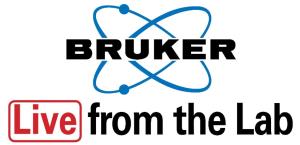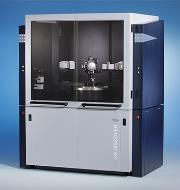|
In this issue: Launch of the Q4 TASMAN Series 2, TXRF uncovers Se deficiency in COVID-19 patients, new "What is SC-XRD?" and S6 JAGUAR videos, XRM analysis of potato crisp, young molecular biologist wins Xavier Solans 2020 prize in X-ray crystallography, XRF for ensuring food quality and safety, SC-XRD detector absorption efficiency, iPad raffle winners, and chaperone crystallization kit for D8 QUEST and D8 VENTURE.
|
|
|
| |
|
Innovation with Integrity
|
|
|
|
|
| |
FIRST
Newsletter
X-ray & Elemental Analysis
|
| December 2020, Issue 56 |
|
|
|
| |
The Gift of Science
|
|
Now nearly ten months into the pandemic, with the holidays nearly upon us, we at Bruker would like to take a moment to recognize the many researchers and scientists who have been at the forefront of our battle against COVID-19 this year. They may not be medical doctors, nurses, clinicians, or even involved in healthcare, but they are frontline, essential workers nonetheless.
They are the molecular biologists, investigating coronavirus proteins that attack the human immune system. They are the analytical chemists, studying nutritional elements like selenium and zinc. They are the materials engineers, developing better polymers and fibers for face shields and masks that serve as personal protective equipment. They are the graduate students and lab technicians, keeping their analytical X-ray instruments running day and night, creating test kits, packaging, study protocols, reagents, treatments, and all manner of scientific advancements that promise a lasting positive impact.
Scientists seek silver linings in challenge and hardship, and bring us optimism for the future. We wish you the gift of science this holiday season, and throughout 2021.
|
In This Issue
|
 |
We're excited to announce the launch of our Q4 TASMAN Series 2, a versatile, benchtop spark Optical Emission Spectrometer (OES) for the metals industry. The Q4 TASMAN Series 2 employs MultiVisionTM, allowing a choice among single- or dual-optics, and SmartSparkTM, the digital spark source, to provide reliable, precise and fast elemental analysis results. The analytical range for many elements has been extended, and new element sets have been added, enabling analysis of new alloy types. New features and capabilities have been added to OES software ELEMENTAL.SUITE for version 3 as well.
Read more
Watch webinar
|
|
|

|
SARS-CoV-2 infections cause the current coronavirus disease (COVID-19) and challenge the immune system with ongoing inflammation. Several redox relevant micro-nutrients are known to contribute to an adequate immune response, including the essential trace elements Zn and Se. Total Reflection X-ray Fluorescence (TXRF) analysis is a well-established method for rapid quantification of trace elements in biological matrices. The TXRF spectrometers S4 T-STAR and S2 PICOFOX installed at the Institute for Experimental Endocrinology, Charité Berlin, Germany were intensively used during recent COVID-19 studies.
Read more |
|
|
 |
"What is Single Crystal X-ray Diffraction?" is the question that's answered in our new educational video, now available on our YouTube channel. The video gives some instructive insights into what SC-XRD is, where it is used, and what kinds of analytical information it provides. It also explains the difference between constructive and destructive interference, and provides details about the derivation of Bragg's law, which is essential to understanding X-ray diffraction.
Watch video
|
|
|
 |
3D X-ray microscopy (XRM) offers the possibility to visualize and characterize microscopic features in food. The texture of processed foods is a major criterion for sensory attributes that are critical for consumer acceptability and preference. Understanding texture perception requires knowledge of the food structure comprising microstructural elements of varying size and purpose, including oil, water, fibers, fat, ice crystals, and gas bubbles. In Method Note 135, we present an automatic image processing workflow through CTAn that lets you segment and analyze in 3D the various phases of a potato chip.
Read more
|
|
|

|
Albert Castellvi (Molecular Biology Institute of Barcelona, Department of Structural Biology, Crystallographic methods group) has been awarded, by unanimous decision of the jury, the Xavier Solans 2020 prize for his work published in Nature, Scientific Reports, "Efficacy of aldose reductase inhibitors is affected by oxidative stress induced under X-ray irradiation".
The jury highly appreciated the novel idea, described in the work, of using synchrotron radiation for the generation and study of reactive species that are produced in oxidative stress that occur in tumor or diabetic cells. With an appropriate irradiation protocol, the authors demonstrate that specific conditions or desired modifications can be induced in a controlled manner in the experiment, avoiding the problems associated with the chemical generation of these species," writes the Secretary of the GE3C.
The Xavier Solans Prize tries to keep alive the memory of an excellent researcher, a promoter of GE3C and Crystallography in Spain, especially of the involvement of young people in this interesting area of scientific research. The Xavier Solans Award, constituted by the Specialized Group for Crystallography and Crystal Growth (GE3C - RSEQ and RSEF), and Bruker, rewards the best scientific contribution made during the previous year in the field of Crystallography and Crystal Growth by a young researcher. The awarding will take place in an academic event within the framework of the next Congress of the Specialized Group on Crystallography and Crystal Growth that will be held virtually in Vigo.
|
|
|
 |
The globalized food supply chain poses serious challenges to producers, brands, consumers, and governments. Ever-intensifying worldwide competition, a growing number of contaminants and a strong demand for food quality control are constantly increasing the number of stringent regulations. X-ray fluorescence (XRF) spectrometry is a versatile technique for fast and reliable elemental analysis of raw ingredients, food components, and edible products, allowing users to monitor food quality at various production steps. In this report, we present analytical results for several food applications, showing the performance of Bruker's XRF solutions.
Read more
|
|
|
 |
Single X-ray photon-counting at first sounds like the ultimate an X-ray detector can offer with respect to sensitivity. However, single photon-counting is an important feature, but not sufficient. In particular, when it comes to harder radiation, such as Mo-Kα [0.7107 Å], Ag-Kα [0.5609 Å] or even In-Kα [0.5136 Å], absorption efficiency becomes an important issue. Our PHOTON II and PHOTON III detectors offer close to 100% absorption efficiency over the entire energy range. While other detectors for hard radiation only absorb 50% or less of the incoming X-rays, the PHOTON II and PHOTON III series "sees" all the high-energy photons. Not surprisingly, at the end of the day, this results in more accurate determination of the crystal structure at the wavelengths typically used in chemical crystallography.
Read more |
|
|

|
Customer Satisfaction Survey
Raffle Winners
Thank you to everyone who participated in Bruker AXS's recent Customer Satisfaction Survey. Respondents had the chance to participate in a raffle to win a new Apple iPad. The five lucky winners were:
- (Lucky Draw No. 323) Kate Michie, University of New South Wales, Australia
- (Lucky Draw No. 87) Customer from Italy
- (Lucky Draw No. 290) Piergiulio Cappelletti, Federico II University, Italy
- (Lucky Draw No. 258) Matthias Steinwand, Solvay Fluor GmbH, Germany
- (Lucky Draw No. 370) Customer from Germany
Congratulations to all!
|
|
|
 |
Chaperone assisted crystallization is a well-established approach in protein crystallization, where chaperone proteins help stabilize other macromolecular structures via covalent or non-covalent chemical bonds. Recently, the group of Prof. C. Richert at the Institute of Organic Chemistry in Stuttgart, Germany has transferred this concept to small molecule crystallography. The group has developed a series of molecules that form co-crystals with many organic molecules and chaperone high-quality crystal formation. With single crystal diffractometers such as D8 QUEST and D8 VENTURE, this approach allows complete 3D structure analysis in a very short time. The new approach can also pave the way to unambiguously determine the absolute structure from liquid samples, previously intractable to even the most sophisticated crystallization methods. Chaperone Crystallization Kits are now exclusively available from Bruker for X-ray crystallographers worldwide.
Learn more
|
|
|
|
|
|
|
| |
 |
| We are continuing our offer of an EIGER2 R 500K detector as an upgrade for D8 DISCOVER and D8 ADVANCE DaVinci systems, at 20% off list price.
|
|
| |
 |
| In light of the ongoing COVID-19 pandemic, there is increased interest in research related to control and prevention of the disease through improvement in personal protective equipment. For face masks that filter airborne particulates, the fiber orientation of the inner melt-blown layer is an important 3D microstructural feature, as it affects properties such as air permeability, water diffusion and bending rigidity.
A small piece of an FFP2 face mask was scanned with SKYSCAN 2214 at a pixel size of 1 µm. The images above show the color-coded local orientation distribution of the fiber network inside the inner and outer filter layers, evaluated with 3D.SUITE. On the right, an XY cross-section of the mask illustrates that the inner melt-blown layer (dense fiber network) appears to have a stratified orientation indicated by the altering greenish and reddish color along the Y-axis direction.
|
|
| |
 |
| Live from the Lab is a series of YouTube videos where we explore Bruker AXS technologies and products. Each month we broadcast live from the Application Studio in Madison, Wisconsin or Karlsruhe, Germany, and discuss techniques and applications with experts from a wide range of fields. Subscribe to our YouTube BrukerTV channel for the livestream or binge-watch the episodes later on-demand.
Watch now:
Sep: Resolution in XRM
Oct: Perfect Powder Diffraction Data, Automatically?
Nov: What is Combustion/Fusion Analysis? |
|
| |
 |
| Bruker Training Office Hours are drawing to a close for 2020 as of December 17th. Look for a series restart in 2021.
In the meantime, check out our fee-based 2020/2021 User Applications Training courses, being offered in English from our "Madison - DIGITAL" location, for XRD and XRF. Our complimentary live and on-demand webinars provide excellent online learning opportunities on all our technologies as well.
We look forward to seeing you again next year!
|
|
| |
 |
| Bruker offers pre-owned and demo systems for an attractive price. All systems are completely refurbished and come with a one-year warranty. Currently available for XRD: one D8 DISCOVER and one D8 ADVANCE.
Get the details |
|
|
|
|
|
|
|
|
|
| |
|
© 2020 Bruker Corporation
|
|
| |
|
|
Connect with Bruker Nano Analytics:
 
|
|
| |
|
|
|
|